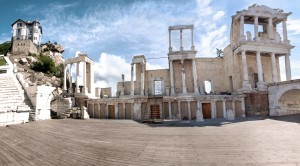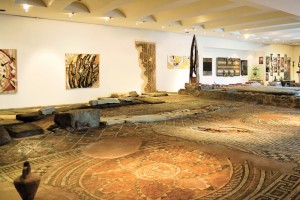Index
129,071 total views, no views today
 Plovdiv is one of the oldest cities in Europe. It is claimed that the city is a contemporary of Troy and Mycenae, but it is more ancient than Rome, Athens and Constantinople.
Plovdiv is one of the oldest cities in Europe. It is claimed that the city is a contemporary of Troy and Mycenae, but it is more ancient than Rome, Athens and Constantinople.
Historians do not indicate the exact age of Plovdiv. In 1975 the remains of a religious building from a Cretan-Mycenaean culture are being revealed, which is equally evaluated with the discoveries in Kronos Island.
Plovdiv is famous with its historical and cultural heritage, which dated back to the Thracian times – the oldest population, for which written sources were found on the Balkan Peninsula. The Thracians had a great culture, which incorporated with other different cultures.
The development of the city is related to the era of Philip of Macedonia. It flourished in the period of heyday of the Roman and Byzantine empires and has preserved to some extent over the years of the Ottoman Empire and reached its rise during the Renaissance.
 The ancient history of the city leaves permanent marks in its architecture. Remains of Old World, Middle Ages, Renaissance and modern culture coexist entangled in the irresistible beauty of this eternal city.
The ancient history of the city leaves permanent marks in its architecture. Remains of Old World, Middle Ages, Renaissance and modern culture coexist entangled in the irresistible beauty of this eternal city.
Plovdiv has preserved many extremely valuable monuments, of which the most impressive are: the Roman Stadium, the Ancient Theatre, the Odeon, the magnificent colored mosaics, the Aqueduct, the walls, the remains of Thracian settlements.
Nowadays the ancient names of the city are related and interpreted in modern names of tourist facilities – hotels, restaurants, and more.
It is believed that the earliest name of Plovdiv is Kendrisiya / Kendros /. It probably came from the cedar forests for which ancient chroniclers wrote or from Thracian tribe – kendrisi. The Thracians first established a fortified settlement on the Three Hills and called it Evmolpia or Evmolpeida. Some scientists link the origin with the Thracian hero Evmolpus or Vestal Virgins in the temples – Evmolpeya.
In 342 BC Philip II of Macedonia /or his troops/ has conquered the city. This event was followed by another change of the name. The city was named Philippopolis, which means City of Philip. During this period, the village has grown considerably, while becoming one of the starting points of colonizing activity.
At the time of the Roman Emperor Claudius the Empire included the Thracian lands within its borders, and the city became the center of the Roman province Thrace. Again Trimontsium (means City of three hills) turned into an important center of economic and cultural life. Here taxes were being gathered, coins were being forged, glamorous buildings, aristocratic homes and impressive walls were being built. Roman era /I-VI century/ is one of the most significant periods of Old World, during which Plovdiv was described as majestic.
During the first half of the seventh century the first massive settlements of the Slavs has begun. They in coexistence with Thracians interpreted the name of the city from Philippopolis to Pulpudeva, then it was transformed into Puldin (Plavdiv) and Plovdiv.
129,072 total views, no views today